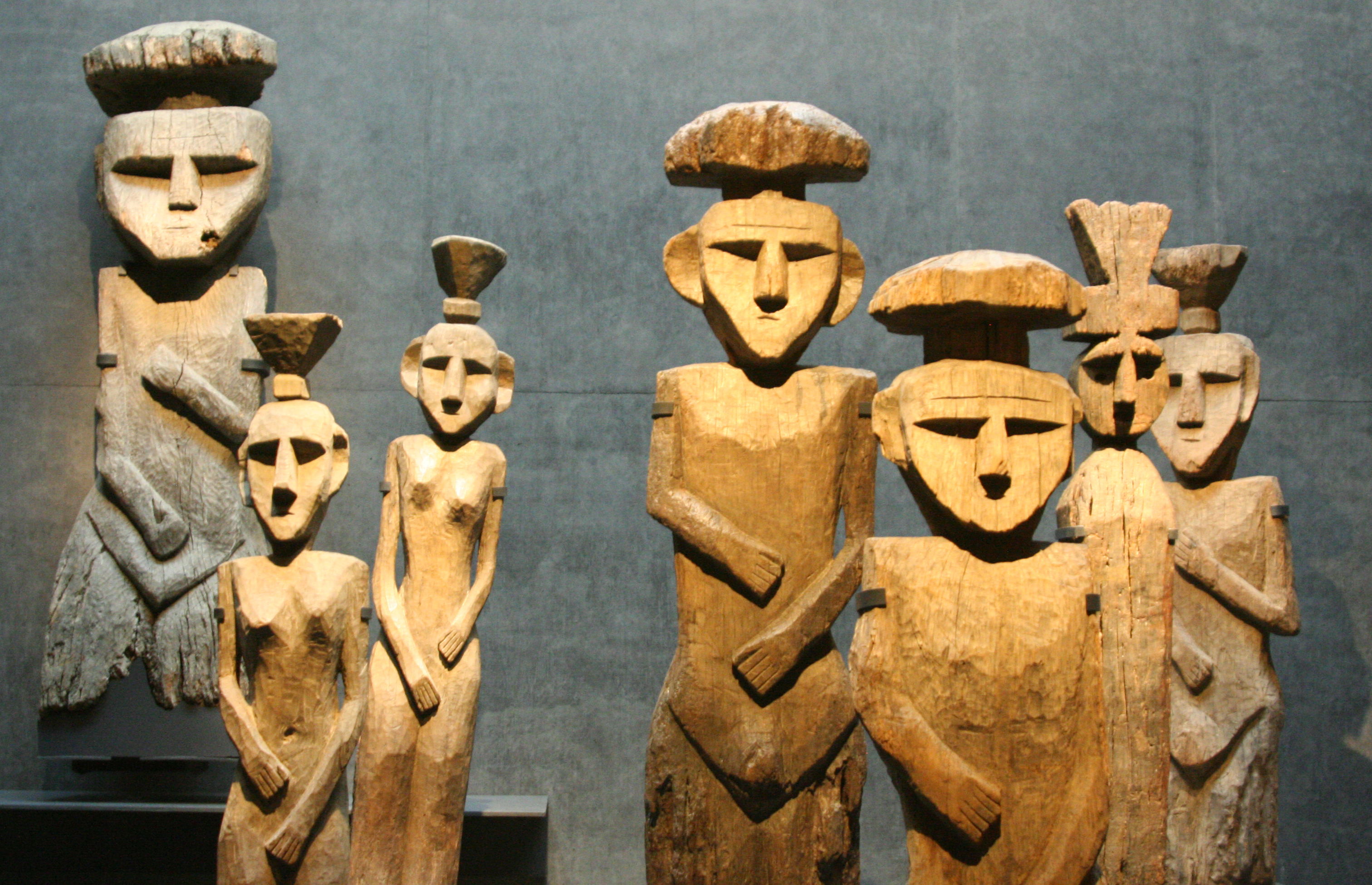The Chilean Museum of Pre-Columbian Art (Español: Museo Chileno de Arte Precolombino) in Santiago, Chile is a jewel among the world’s museums and a highlight of any trip to the country. Widely regarded as one of the best museums in Latin America, this unique establishment houses an impressive collection of artifacts from ancient Central and South America, which underscores the rich cultural and artistic diversity of the Pre-Columbian Americas.
In this exclusive English language interview, James Blake Wiener, Communications Director at Ancient History Encyclopedia (AHE), takes a tour of the museum with Dr. José Berenguer Rodríguez, Curator at the Chilean Museum of Pre-Columbian Art, who explains the finer points of the museum’s history, organization, and vast collection.
JW: ¡Bienvenidos a AHE, Señor José Berenguer Rodríguez! I am delighted to speak to you about the Chilean Museum of Pre-Columbian Art. Your interview is AHE’s first with a museum in South America.
Sergio Larraín García-Moreno (1905-1999), an avant-garde Chilean architect and politician, founded the museum in 1981 so Chileans could learn about the pre-Hispanic heritage of their country and that of their neighbors. Larraín García-Moreno’s life was colorful — he was an MI6 agent in World War II and the Chilean ambassador to Peru in the 1960s — but he had an enduring passion and deep respect for the cultures and civilizations of the ancient Americas.
What do you know about Larraín García-Moreno, as an individual, and how he was able to establish the Chilean Museum of Pre-Columbian Art? Why did he feel that it was important for Chileans to have a museum of ancient art?
JBR: Sergio Larraín García-Moreno was a very special collector, a real oddity at the time among art collectors in our country. Unlike the others, he wanted to share the collection he had amassed throughout his lifetime with the public. To accomplish this, he established a foundation, which own his art collection today, and signed an agreement with the Municipality of Santiago for the restoration and use of a beautiful colonial palace where the permanent exhibition could be displayed.

The “Feline Man.” Rattles like those found in the feet of this large vessel can be seen in many Central American pieces. These are thought to have been shaken during ritual ceremonies in accompaniment to singing and dancing. (Photo Credit: Claudio Mercado, Museo Chileno de Arte Precolombino.)
The Chilean Museum of Pre-Columbian Art has operated out of that building for just over 34 years now. Larraín García-Moreno founded the museum to realize his dream of enabling young people — not only in Chile but from across our continent — to learn about and appreciate the pre-Hispanic Americas and recognize themselves as the heirs to a common past. In a very real and at the same time very profound sense, Larraín García-Moreno’s message in the early 1980s was also meant for generations that were not yet born but were already on his mind. He used to say that art is the best way to reach people’s spirits, and what he wanted was to move them with these masterpieces.
JW: I have read that Chilean Museum of Pre-Columbian Art selected many of the artifacts on display due to their artistic merit rather than scientific or anthropological significance. In your opinion, what is it that differentiates the Chilean Museum of Pre-Columbian Art from other museums in Latin America with a focus on ancient art?
JBR: It is true — Larraín García-Moreno chose most of the pieces essentially according to aesthetic criteria. Many of them are unique artifacts, true works of art in the way we use the term in the West. But he also maintained very close ties with archeologists and anthropologists, who made him aware of the importance of taking into account the cultural context of the works, which are archeological objects after all. In fact, it was archeologists like Junius Bird (1907-1982) and Alberto Rex González (1918-2012), among others, who convinced our founder that he could not allow his art collection to be dispersed when he passed away.
So when it came time to display his collection as the permanent exhibition of the Chilean Museum of Pre-Columbian Art, in 1981, Larraín García-Moreno hired archeologists — not aesthetes or art historians — to catalog the objects and draft the accompanying descriptions. He knew perfectly well that the pieces were not merely beautiful objects; some of them were ritual pieces, many of them were sacred, and all of them were instilled with historic, functional, and symbolic content.
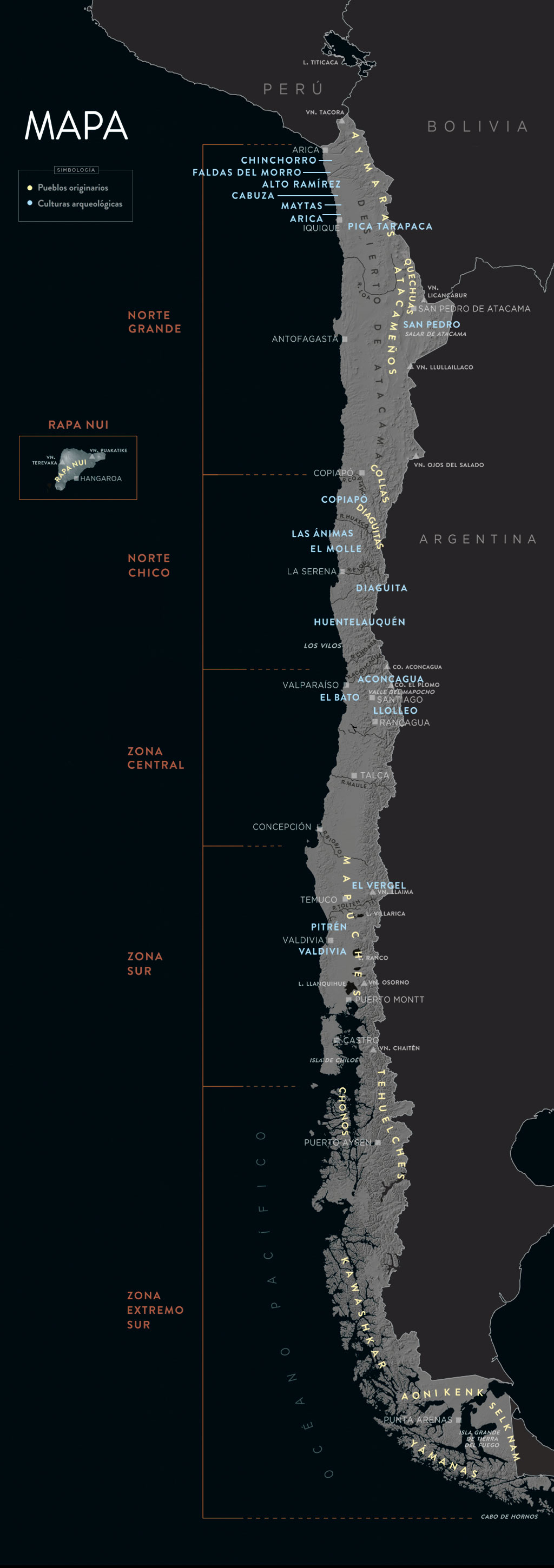
Although Spanish conquistadores conquered what is present-day Chile in the 1550s CE, one can find the remains of Chile’s ancient and prehistoric past across the length of the country. This map shows the major cultural and archaeological zones found in Chile. (Photo Credit: Courtesy of Museo Chileno de Arte Precolombino.)
“Chile dates back much further than Allende and Pinochet…our history began thousands of years before the arrival of the Spaniards…”
I would say that three main features set our museum apart:
1.) The fact that while most Latin American museums usually exhibit collections of “antiques” — pieces dating after European contact — ours goes much further back to exhibit ancient art from pre-Hispanic times. So when we talk about “old” art, we are referring to art produced thousands of years ago, not during colonial or republican eras.
2.) Ours is one of the few museums (or perhaps the only one) that exhibits pre-Columbian collections from virtually the entire American continent. So we have an “Americanist,” rather than a nationalist, vision of the pre-Columbian past.
3.) The pieces in this museum’s exhibitions are always treated as “objects of meaning,” in other words, objects that hold meaning. They are not in their display cases merely to be contemplated, or to speak for themselves; they also are there to convey what expert knowledge and indigenous knowledge has to say about them. Obviously, in the few cases in which we know virtually nothing about certain objects, we always “respect their silence.”

A ceramic anthropomorphic figurine created by the Olmecs in ancient Mexico, c. 1200-900 BCE. (Photo Credit: Claudio Mercado, Museo Chileno de Arte Precolombino.)
JW: Over 10,000 years of art and history permeate the museum, which recently reopened in 2014 after an extensive three-year renovation undertaken by the Chilean architect Smiljan Radic. Objects are arranged by cultural zones or regions: Mesoamerica; Intermediate Area; Caribbean; Amazonian; Central Andes; Southern Andes; and Chile.
In these galleries, the museum visitor can find everything from a Maya stele and wooden vomit spatulas used by Amazonian shamans, to beautiful Andean textiles and the massive ceramic urns of the Aguada culture (c.600-900 CE). Among all of the artifacts, which are particularly special to you and why?
JBR: It depends on the criteria we use. From an aesthetic perspective, my favorite is the “Veracruz girl” ceramic statue, with her fine facial features, her subtle hand gesture, her cephalic deformation, and her huipil (Mayan square-cut blouse). She is beautiful from any angle. As a curator, I would prefer the figure on the Moche ceramic bottle as it presents an intriguing challenge: Does it actually represent a medicine man, as the display text says, or is it a pot-maker or a pot-seller? We do not know.
On the basis of excellence in workmanship and the quality of the final product, my favorite is the Chimú ceremonial ensemble, which includes three items of clothing that comprise an outfit that is stunning for its textile techniques, its colors, and above all its iconography, which evokes a garden similar to the ones that used to exist in the labyrinthine mud-walled citadels of that ancient, northern Peruvian coastal culture.
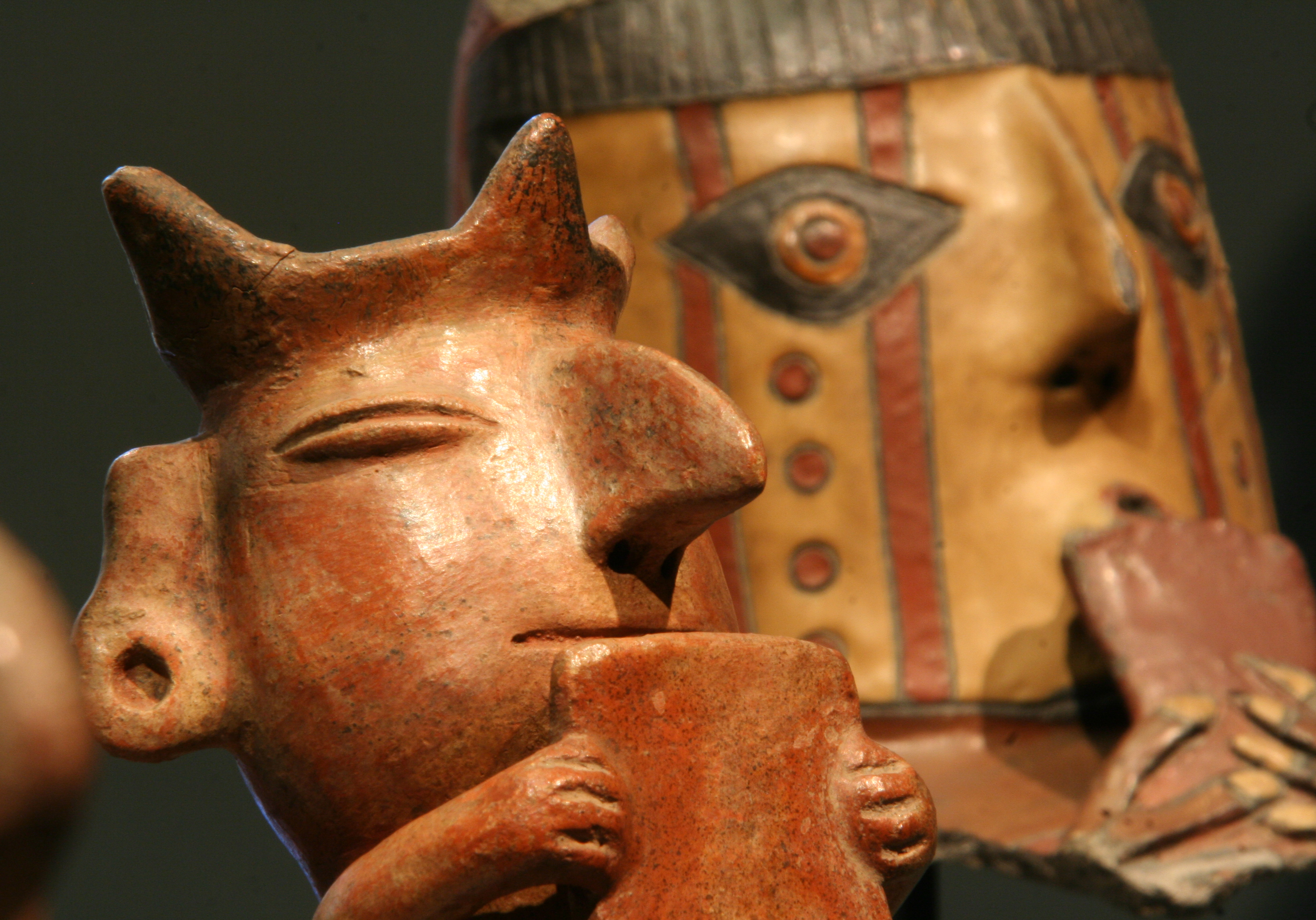
Musical instruments from the Andean world include flutes, trumpets, drums, and gourd or metal rattles. These were used in ritual or ceremonial situations, where music and dance helped to produce certain states of consciousness in people, or represented the authority and symbolism of specific individuals. (Photo Credit: Claudio Mercado, Museo Chileno de Arte Precolombino.)
JW: Following my previous question, do visitors to the museum comment on any artifacts in particular?
JBR: Visitors are very impressed with Xipe Totec, a ceramic statue from the Veracruz culture (300-900 CE) that represents the god of spring, who embodies the fertility of all flora. I think that is because of its size — it is almost as big as a child — and because it is covered with monkey hide.
Now, when people find out that that statue shattered into a thousand pieces during the 1985 earthquake, spent many years in the “surgery” of the restorer, and was returned to the gallery when Chile returned to democracy in 1990, well, one realizes that the modern story of the Xipe Totec statue is similar to its prehistoric one. Or perhaps the two stories converge, as our Xipe Totec seems to symbolize the rebirth or reconstruction that is needed every year in some regions of Chile after a natural disaster.
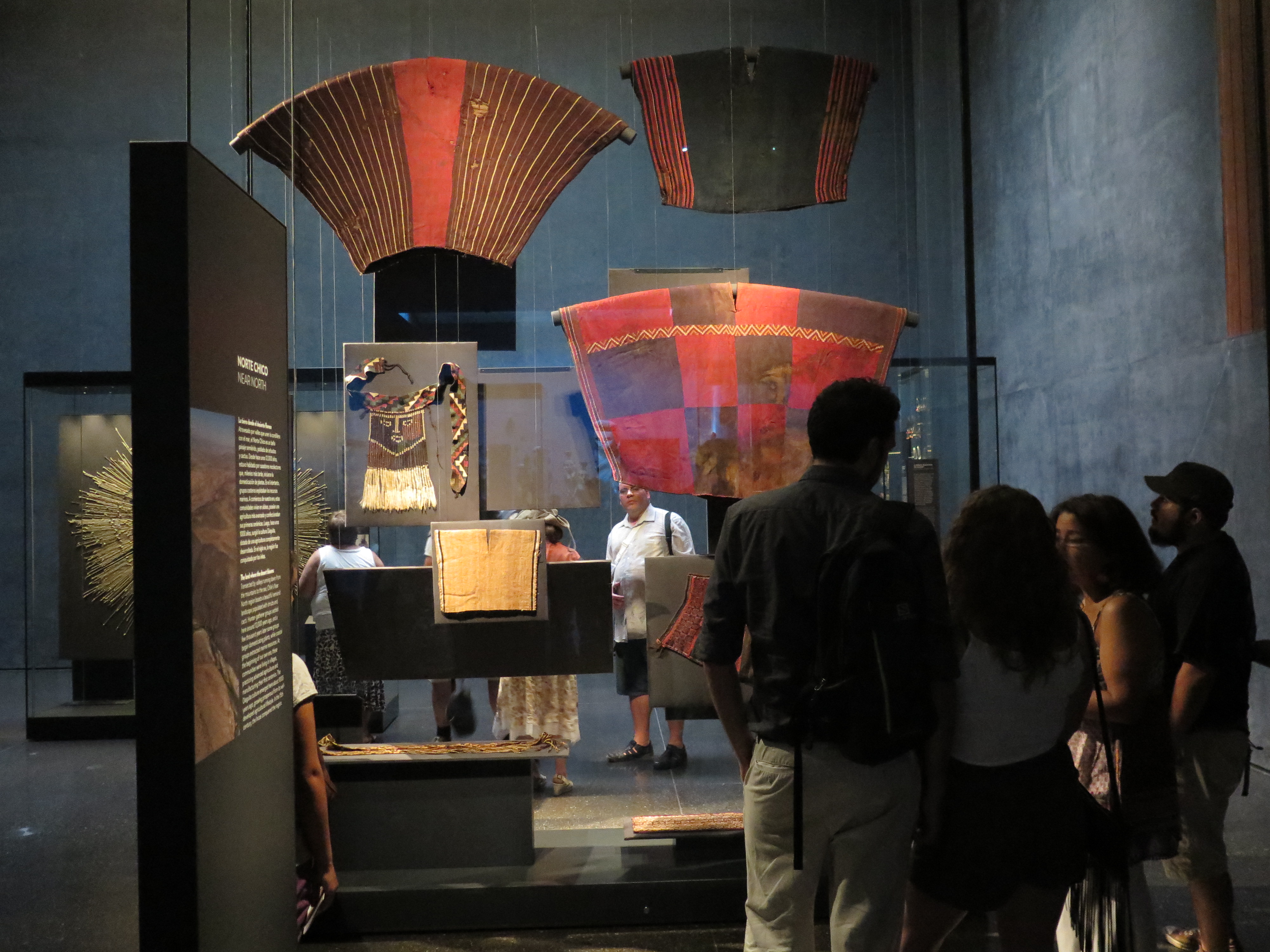
The “Chile before Chile” exhibit includes more than 400 artifacts from Pre-Columbian peoples and their descendants, all housed in a new, specialized gallery. (Photo Credit: Pablo Espinosa, Museo Chileno de Arte Precolombino.)
JW: I wanted to make special mention of the Chile before Chile (Español: Chile antes Chile) exhibition at the Chilean Museum of Pre-Columbian Art.
When many people outside of Latin America think of Chilean history, they think of more recent history along the lines of the socialist President Salvador Allende or the military dictatorship of Augusto Pinochet. However, humans have inhabited what is present-day Chile since at least 12,000 BCE, and many of the oldest examples of artificially mummified human remains are from Chile’s Chinchorro culture (c. 5000-3000 BCE).
Which ways does this exhibition emphasize the links between the modern Chilean identity and Chile’s ancient heritage?
JBR: The waves of immigrants that have come to Chile in recent times have helped Chileans to realize that we have a serious problem — xenophobia. And so the Chile before Chile exhibition, with its diverse display of cultures and regions, not only shows the world that Chile dates back much further than Allende and Pinochet, but it also shows the Chilean people that our history began thousands of years before the arrival of the Spaniards. Moreover, it conveys the message that a country’s ethnic and cultural diversity, far from being a burden, actually enriches it.
“The pieces in this museum’s exhibitions are always treated as ‘objects of meaning’, in other words, objects that hold meaning…”
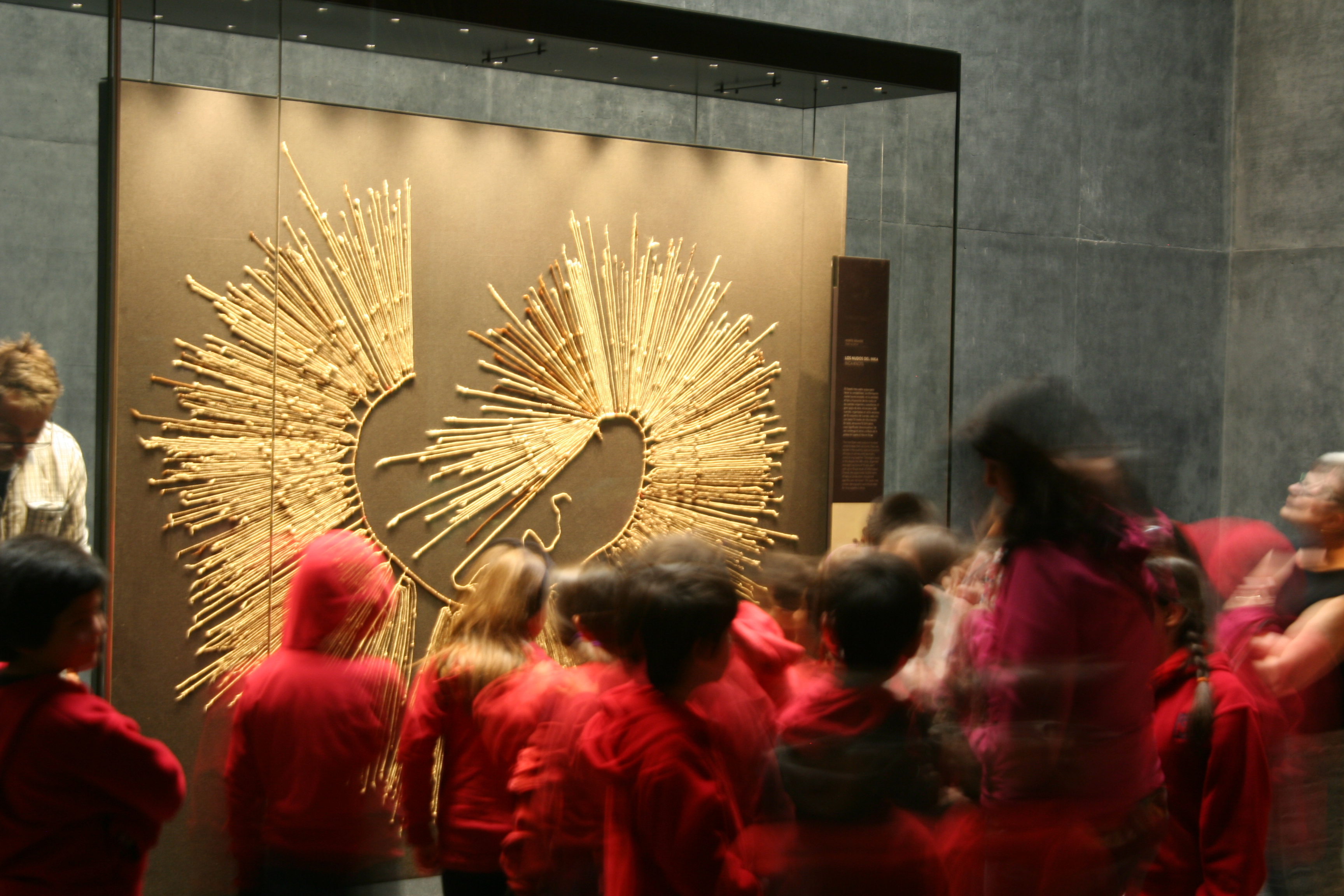
Special attention is given to the time period in which present-day Chile was under the control of the Incan Empire in the fifteenth and sixteenth centuries CE in “Chile before Chile.” (Photo Credit: Claudio Mercado, Museo Chileno de Arte Precolombino.)
JW: Are there any special exhibitions or activities currently planned for 2016?
JBR: In late November this year, we will inaugurate a new exhibition on the Diaguita, a culture that developed in Chile’s semi-arid north between 900 and 1450 CE and was conquered by the Inca not long before the arrival of the Spaniards. The Diaguita are renowned for their beautiful, multicolored ceramic pieces, covered with decorative geometric and figurative designs, many of which appear to be inspired by shamanic journeys. This art has been adopted and reworked by contemporary muralists from the same region, who have painted their designs in towns and cities to show that, in some way, they feel like Diaguitas too.
In other words, the past is being used to reformulate the cultural identities of the present. Because of this, one of the working titles of the exhibition is The Art of Being Diaguita, referring to the exhibit’s overall focus on both past and present identities as seen through the lens of art.
JW: Curator Berenguer Rodríguez, I thank you so much for speaking with us. I hope to see you in Santiago in the near future! ¡Saludos!
JBR: My pleasure, James. Thank you very much for your interest in our museum. We invite everyone to schedule a visit to the Chilean Museum of Pre-Columbian Art when they visit Santiago, Chile.
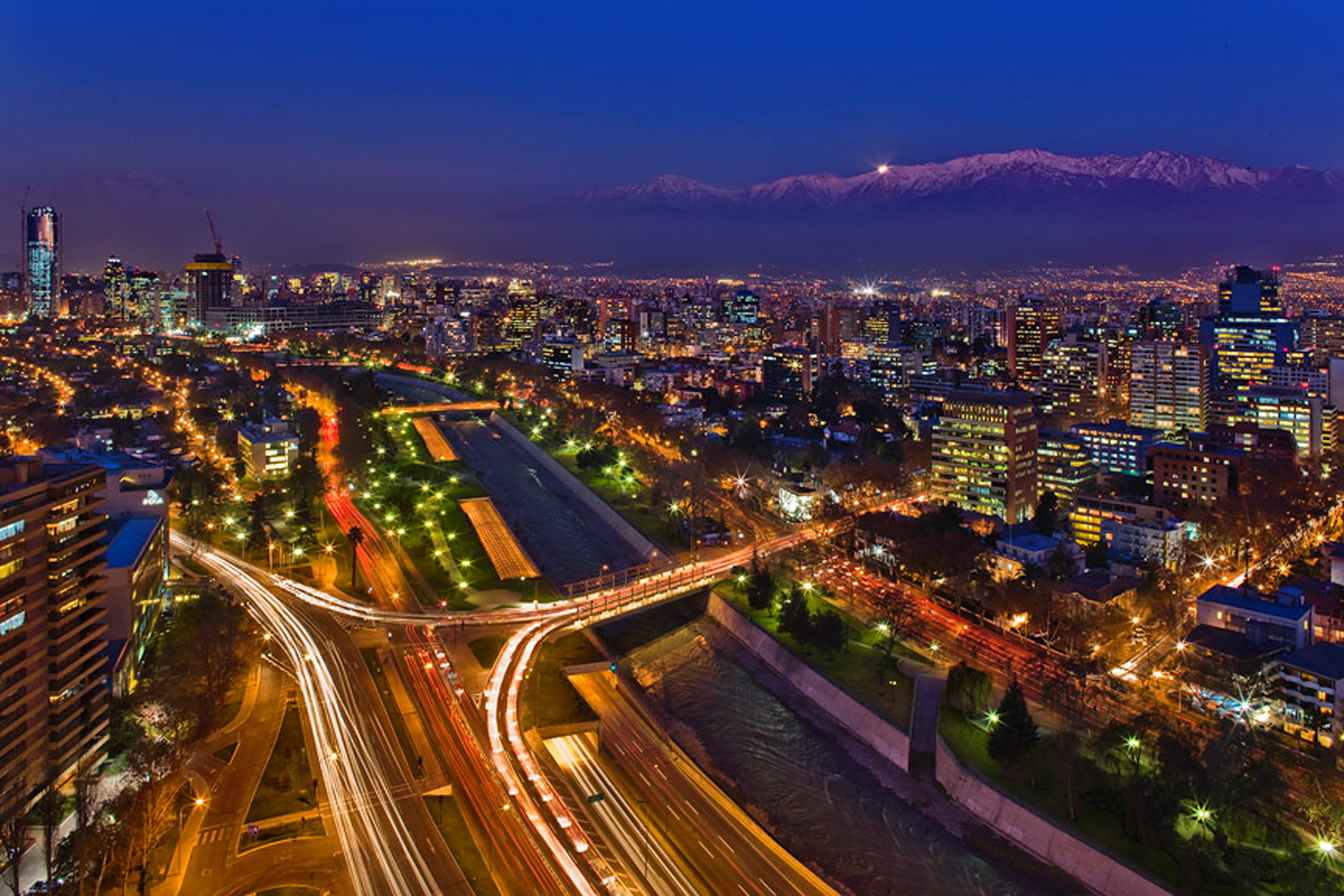
Santiago de Chile is the fifth largest city in Latin America, and among the most cosmopolitan and lively. (By Javmoraga – Own work, CC BY-SA 3.0, https://commons.wikimedia.org/w/index.php?curid=22740720.)
Getting to the Chilean Museum of Pre-Columbian Art
The museum is located in the heart of downtown Santiago at Bandera 361, on the corner of Bandera and Compañía streets, just one block from the city’s main square, Plaza de Armas. The museum is easily accessibly by Metro as it is situated very close to the Plaza de Armas metro stop, which is on Linea 5 (the Green line).
Museum Information
The museum is open from Tuesday to Sunday, 10:00 AM to 6:00 PM. However, it is closed on Mondays. On the first Sunday of each month, entrance to the museum is free of charge. The museum is closed on January 1, March 25, May 1, June 5, September 18, October 23, and December 25.
General Public $$4.500 CLP
Students: $2.000 CLP
Seniors: $3.000 CLP
Children (under 10) and school visits: Free of charge
The Chilean Museum of Pre-Columbian Art offers guided visits for groups and teachers. Their website also offers free MP3 Audio Guides available for download. They are available in English, French, Portuguese, and Spanish. These are arranged by the cultural areas, following the same order of the galleries.
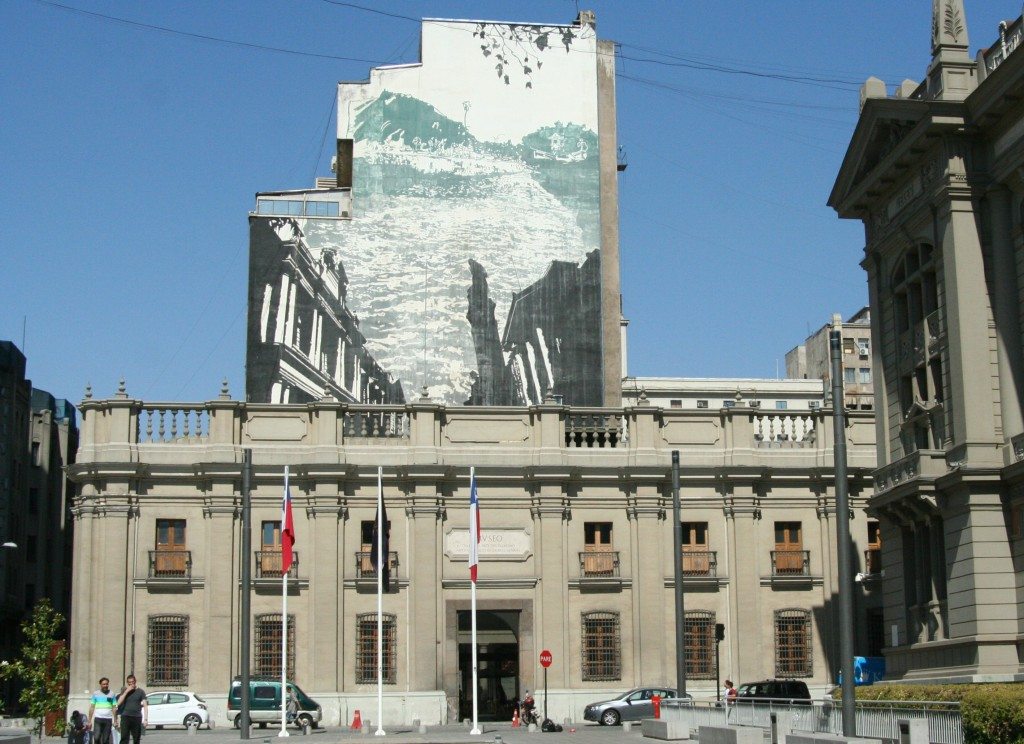
The Chilean Museum of Pre-Columbian Art, located in downtown Santiago de Chile, has a collection of over 5,000 artifacts. (Photo Credit: Claudio Mercado, Museo Chileno de Arte Precolombino.)
 Trained as an archaeologist at the University of Chile, José Berenguer Rodríguez earned his Ph.D. in Anthropology from the University of Illinois at Urbana-Champaign. He is the Chief Curator of the Chilean Museum of Pre-Columbian Art, the Editor of the Boletín del Museo Chileno de Arte Precolombino, and a specialist in the prehistory of the Atacama desert, particularly during the interval between Middle and Late (Inka) periods. The long-term emphasis of his research has been in the spatial, social, and ritual aspects of the human interaction in South Central Andes, at a local, regional, and interregional level. This broad subject has been approached by Berenguer through different research lines, including the study of ceremonialism, pathways and roads, spatialization and territorialization processes, trading and traffic networks, rock art, and the iconography of artifacts such as the complex psychotropic.
Trained as an archaeologist at the University of Chile, José Berenguer Rodríguez earned his Ph.D. in Anthropology from the University of Illinois at Urbana-Champaign. He is the Chief Curator of the Chilean Museum of Pre-Columbian Art, the Editor of the Boletín del Museo Chileno de Arte Precolombino, and a specialist in the prehistory of the Atacama desert, particularly during the interval between Middle and Late (Inka) periods. The long-term emphasis of his research has been in the spatial, social, and ritual aspects of the human interaction in South Central Andes, at a local, regional, and interregional level. This broad subject has been approached by Berenguer through different research lines, including the study of ceremonialism, pathways and roads, spatialization and territorialization processes, trading and traffic networks, rock art, and the iconography of artifacts such as the complex psychotropic.
All images featured in this interview have been attributed to their respective owners. Edited by James Blake Wiener for AHE. Special thanks is extended to Ms. Paulina Roblero Tranchino at the Museo Chileno de Arte Precolomibo for facilitating this interview. Unauthorized reproduction is strictly prohibited. All rights reserved. © AHE 2016. Please contact us for rights to republication.
